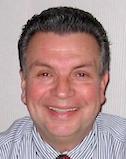A Moment in Bank History: The Secrets of 1 CMP
Working Without Windows in 5B
Eugene Ret Writes About "The Vault"

It was April 1974. I was a young, newly hired fledgling supervisor in the Security Services Group at 1 Chase Plaza. I managed the Coupon Cutting & Blocking Unit located outside the Trust Vault on floor 5B. At that time, bearer bonds were the fashion for most corporate, municipal and government bonds, requiring the removal and presentment of coupons semi-annually to receive interest payments.
Working 90 feet below ground surface took some getting used to. With no windows, scenic outdoor landscape photos and pictures were the order of the day. But as time passed, I came to appreciate the true wonders and secrets of floor 5B and the vault.
Constructed between 1958 and 1961, the 5B vault at 1 CMP was touted as one of the most secure in the world. In actuality it was comprised of three vaults: the Trust Vault for customers' securities, Safe Deposit and Precious Metals Vaults. Constructed of reinforced concrete and steel, it was larger than a football field and had multiple vault doors each weighing 30+ tons. These doors were perfectly balanced, and you could swing them open or closed with one hand. Each door had three clocks set as a redundancy for the hours that the doors could not be opened once locked. An air pneumatic tube system connected the Trust Vault to floors above and was used to retrieve and deliver sold securities to the proper servicing area for messenger delivery to other banks or brokerage houses.
At one time, vault tours were offered to the public, and, in answer to the common question “Any samples?”, a Lincoln penny minted in 1961 (the year the building was opened) was affixed to a card with a picture of a Bank Guard and given as a souvenir.
In addition to customers' securities, the Trust Vault contained $5 million in “ransom cash”. Due to the frequency of airplane hijackings at the time, a number of banks were asked to maintain quick access to cash to meet ransom demands.
Due to its proximity to the Fed of New York and Chemical Bank, there were tunnels from 5B to these other institutions to facilitate the movement of cash or precious metals among our institutions.
Surrounded by the New York City subway system, we could frequently hear the rumbling of trains, and on quiet days we could hear commuters entering the turnstiles.
The Precious Metals Vault had an air-filtration system that collected precious metal air particles. The filters were periodically cleaned and particles collected to later be sold and melted.
The Bank's records of customer-owned securities held and transacted were at that time managed on 80- column Hollerith keypunch cards. The conversion to a more IT data management environment and system later named STAR was undertaken by a newly formed data management team managed by Arthur F. Ryan. No surprise that this conversion was successful.
So much for my time as one of the “mole-people”, as we were referred to by colleagues with windows above ground.
Comments
I recall a day visiting two Vault Trust staff on 5B as the DJIA and CMB stock were plummeting. One staff member was close to tears as she shared her TIP was 100 percent invested in the E Fund. That was a “life lesson” day for me: diversity.
And yes, many of us had our first Safety Deposit Box in those Vaults below Nassau Street.
I first met Gene when I managed the 4B Data Center in the mid 1980s. And since there were terminals and printers in the Vault, on occasion I was granted access to the vault to repair or replace the computer equipment. But CMP-4B was not without its nuances. And since the cafeteria was located on 1B, if there was an incident in the data center early in the morning, or late in the the afternoon, you might never see the light of day. However, there was an upside … There was an air intake valve in the data center that would bring in cool air in the event that there was a temperature rise in the computer room. But more importantly when the the pizza and Chinese food trucks parked near the intake valve, you always knew when it was time for lunch.
